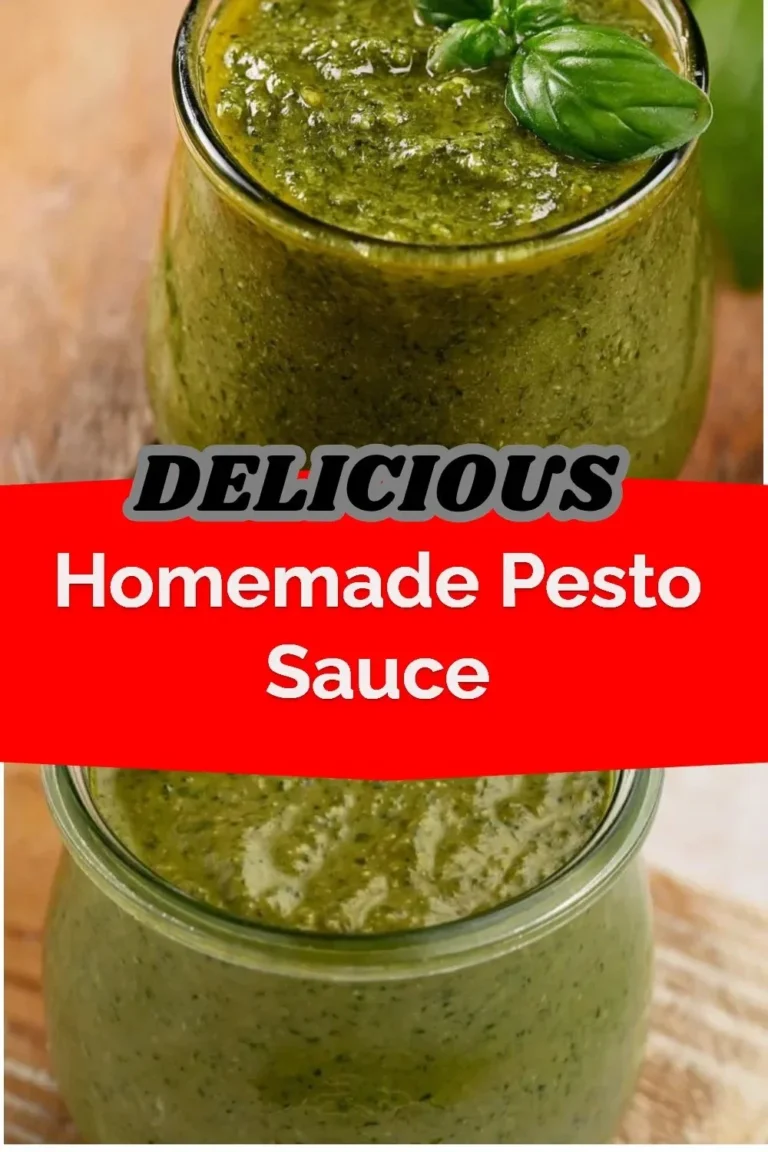Homemade Pesto Sauce
Why Make This Recipe
Homemade Pesto Sauce is a delightful addition to many dishes. It is simple to make and brings a fresh herb flavor to your meals. Made with fresh basil, Parmesan cheese, olive oil, pine nuts, and garlic, this sauce bursts with flavor. By creating your own pesto, you can control the ingredients and make it exactly how you like it. Store-bought versions often come with preservatives or unnecessary additives, so making it at home allows you to enjoy a pure, naturally delicious product.
Cooking is a great way to experiment with different flavors, and homemade pesto is no exception. It pairs well with pasta, sandwiches, pizza, and even grilled meats or vegetables. When you make your own pesto, you can tailor it to your taste. Add more garlic for a bolder flavor, or toss in some sun-dried tomatoes for a sweeter twist. Whatever way you choose to enjoy it, homemade pesto is an easy, rewarding culinary experience.
How to Make Homemade Pesto Sauce
Creating your own pesto sauce at home is a simple process that takes just a few steps. Here’s a rundown on how to prepare this flavorful sauce that you can use in many dishes.
Ingredients
To make homemade pesto sauce, you will need:
- 2 cups fresh basil leaves
- 1/2 cup grated Parmigiano-Reggiano cheese
- 1/2 cup olive oil
- 1/4 cup pine nuts
- 1-2 cloves garlic
- Salt and pepper to taste
- Splash of cream (optional)
Directions
-
Gather Your Ingredients: Start by collecting all your ingredients. Having everything in place will simplify the cooking process and make it easier to focus on making your pesto.
-
Prepare the Basil: Rinse the fresh basil leaves under cold water to remove any dirt or impurities. Once cleaned, pat the leaves dry with a clean towel. This step is vital because excess moisture can affect the consistency of the pesto.
-
Combine Ingredients in a Food Processor: Place the basil leaves, grated Parmigiano-Reggiano cheese, pine nuts, and garlic into a food processor. This handy kitchen tool will help blend everything into a smooth sauce.
-
Pulse Until Finely Chopped: Secure the lid on your food processor and pulse the ingredients until they are finely chopped. However, be careful not to over-process; you want a textured mixture, not a liquid.
-
Add Olive Oil: With the food processor running, slowly stream in the olive oil. This will help emulsify the sauce, creating a smoother texture as the oil combines with the other ingredients.
-
Season to Taste: After adding the olive oil, sprinkle in salt and pepper. Blend again until well incorporated. Taste the mixture and adjust the seasoning if necessary to match your preferences.
-
Try a Splash of Cream: If you’d like a creamier pesto, consider adding a splash of cream. Blend again after adding it, and you’ll have a rich, decadent sauce.
-
Serve Over Pasta: Your homemade pesto is now ready! Toss it with cooked pasta for a quick meal, or use it as a dressing for grilled veggies, or as a spread on sandwiches. The possibilities are endless!
How to Serve Homemade Pesto Sauce
Homemade pesto sauce can be served in various ways. Here are a few ideas to inspire you:
-
Pasta Dishes: Toss it with spaghetti, linguine, or your favorite pasta shape. Cook the pasta until al dente, drain it, and mix it with warm pesto for a delicious meal.
-
Sandwiches and Wraps: Spread pesto on sandwich bread, focaccia, or wraps to enhance the flavor. It adds a fresh herb taste that pairs well with turkey, chicken, or roasted vegetables.
-
Pizza Base: Use pesto instead of tomato sauce for a unique twist on pizza. Spread a layer of pesto on your dough and add your favorite toppings.
-
Dip: Serve pesto as a dip with fresh vegetables like carrots, cucumbers, or bell peppers. It makes a healthy and tasty appetizer.
-
Marinade: Use pesto as a marinade for chicken or fish before grilling or baking. It infuses the proteins with flavor.
How to Store Homemade Pesto Sauce
Storing homemade pesto correctly will help you enjoy it for longer. Here are some tips:
-
Refrigerate: Place your pesto in an airtight container. It will keep in the refrigerator for about 5 to 7 days. To minimize oxidation and browning of the basil, pour a thin layer of olive oil over the top before sealing the container.
-
Freeze for Longer Storage: If you want to keep pesto for a more extended period, freezing it is a great option. Transfer the pesto into ice cube trays, cover, and freeze. Once frozen, pop the cubes out and store them in a resealable plastic bag or an airtight container. Frozen pesto can last for several months. When you need some, just take out a cube!
-
Keep Away from Light and Heat: When storing, always keep pesto in a cool, dark place. Heat and light can degrade the flavor and nutrients of the sauce.
Tips to Make Homemade Pesto Sauce
Here are a few handy tips for making the best homemade pesto:
-
Use Fresh Ingredients: Fresh basil leaves make a big difference in flavor. Avoid using wilted or yellowing leaves as they will negatively affect the taste of your pesto.
-
Toast the Pine Nuts: For added depth of flavor, consider lightly toasting the pine nuts in a dry skillet before adding them to the food processor. Just 2-3 minutes over medium heat will enhance their nutty flavor.
-
Customize Your Cheese: While Parmigiano-Reggiano is a classic choice for pesto, you can use other hard cheeses like Pecorino Romano or even some aged cheddar for a different flavor profile.
-
Experiment with Other Herbs: If you want to switch things up, try substituting basil with other herbs like cilantro, parsley, or mint to create unique variations of pesto.
-
Add More or Less Garlic: If you love garlic, feel free to add more than the 1-2 cloves suggested. Conversely, if you prefer a milder flavor, use just one clove or omit it entirely.
Variation
There are so many ways to play around with this classic recipe. Here are a few variations you might enjoy:
-
Sun-Dried Tomato Pesto: Replace half of the basil with sun-dried tomatoes for a sweet, tangy version of pesto.
-
Spinach and Kale Pesto: Add spinach or kale to your basil for an extra boost of nutrients. This variation makes a vibrant green sauce that is packed with vitamins.
-
Nut-Free Pesto: For those with nut allergies, substitute the pine nuts with seeds like sunflower seeds or pumpkin seeds. They provide a similar texture and flavor.
-
Creamy Avocado Pesto: Substitute half of the oil with ripe avocado for a creamy, rich version that’s perfect for spreading.
-
Lemon Basil Pesto: Grate in some lemon zest or add a splash of lemon juice for an extra zesty flavor. This variation brightens up the sauce and adds refreshing citrus notes.
FAQs
What Can I Use If I Don’t Have Pine Nuts?
If you don’t have pine nuts, you can substitute them with other nuts like walnuts, almonds, or pecans. Each nut provides a different flavor, but they all work well in pesto.
Can I Make Pesto Without a Food Processor?
Yes, you can make pesto without a food processor! Simply chop the ingredients finely by hand and mix them together in a bowl. It will take a bit longer, but it can be done.
Why Is My Pesto Turning Brown?
Pesto can turn brown due to oxidation. To prevent this, store pesto in an airtight container and cover the surface with a layer of olive oil. Also, try to minimize the exposure to air when storing.
Can I Use Dried Basil Instead of Fresh?
While using dried basil is possible, it won’t provide the same fresh flavor as using fresh basil. If you only have dried basil, use about a third of the amount you would use with fresh basil, and consider letting it rehydrate in some oil or water before mixing.
How Do I Thicken My Pesto?
If your pesto is too loose, you can add more cheese or nuts to help thicken it. Alternatively, try reducing the amount of olive oil you add, or mix in some bread crumbs for added texture.
Creating your own homemade pesto sauce is easy and fun. With just a few simple steps and fresh ingredients, you can create a versatile and tasty sauce that enhances a multitude of dishes. Whether you’re tossing it with pasta or using it as a sandwich spread, your homemade pesto will become a staple in your kitchen. Enjoy every bite of this delicious flavor booster!
PrintHomemade Pesto Sauce
A simple and fresh homemade pesto sauce made with basil, Parmesan, olive oil, pine nuts, and garlic, perfect for pasta, sandwiches, pizzas, and more.
- Prep Time: 10 minutes
- Cook Time: 0 minutes
- Total Time: 10 minutes
- Yield: 4 servings 1x
- Category: Sauce
- Method: Food Processing
- Cuisine: Italian
- Diet: Vegetarian
Ingredients
- 2 cups fresh basil leaves
- 1/2 cup grated Parmigiano-Reggiano cheese
- 1/2 cup olive oil
- 1/4 cup pine nuts
- 1–2 cloves garlic
- Salt and pepper to taste
- Splash of cream (optional)
Instructions
- Gather your ingredients.
- Rinse the basil leaves under cold water and pat dry.
- Combine basil, cheese, pine nuts, and garlic in a food processor.
- Pulse the ingredients until finely chopped.
- With the processor running, slowly stream in the olive oil.
- Season with salt and pepper, blending until well incorporated.
- If desired, add a splash of cream and blend again.
- Serve over pasta or as a spread.
Notes
Store in an airtight container in the fridge for 5-7 days or freeze for longer storage. Pour a layer of olive oil on top to minimize oxidation.
Nutrition
- Serving Size: 1 serving
- Calories: 250
- Sugar: 0g
- Sodium: 200mg
- Fat: 22g
- Saturated Fat: 4g
- Unsaturated Fat: 16g
- Trans Fat: 0g
- Carbohydrates: 5g
- Fiber: 1g
- Protein: 6g
- Cholesterol: 10mg








